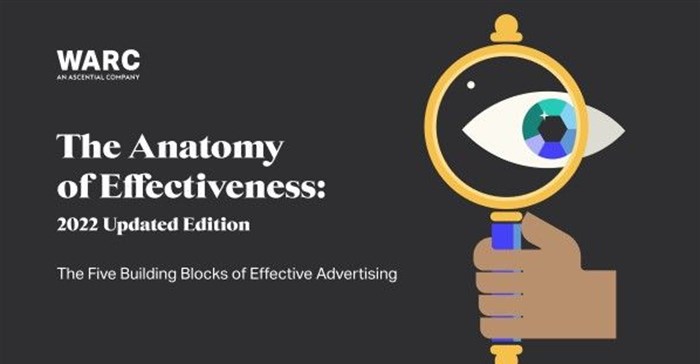5 key priorities for delivering effective advertising

Three years ago in 2019 WARC launched the Anatomy of Effectiveness report at the Cannes Festival. The report presents a framework to help brands and agencies resolve the continuing crisis in creative effectiveness.
The crisis is not over
“In 2019 we noted a sense that advertising, in its current form, was not driving the growth it should be. This was backed up by researcher Peter Field declaring a “crisis in creative effectiveness,” says David Tiltman, SVP content, Warc.
He says that today, there’s no sign that the crisis is over. “In fact, there are a host of new questions and issues to resolve,” he states.
“We’ve had a pandemic that saw budgets switch out of brand investment into performance marketing; we’ve seen the rise of ‘retail media’ platforms that are reshaping the media landscape; and with the impending death of the cookie we see a growing lack of confidence in advertising and media measurement,” he says.
“This updated edition of our white paper draws on new thinking and the latest evidence to present the key building blocks required to deliver commercial impact today,” adds Tiltman.
Five priorities for brands
The updated edition’ highlights five priorities for brands wanting to improve the impact of their advertising:
- Invest for growth
Understanding how factors such as brand size, campaign investment and category dynamics will determine effectiveness are key first steps when it comes to setting budgets and agreeing on objectives. Getting the right framework for investment is crucial if a campaign is to meet its potential.
“Understand the impact of your spend. Leveraging the intelligence of thousands of brands and budgets, Analytic Partners’ ROI Genome shows that the number one driver of business growth is the level of spend on marketing and advertising. This outperforms all other drivers like creative quality or executional elements,” says Nancy Smith, president and CEO, Analytic Partners.
- Balance your spend
Set the right framework for investment to ensure sustainable success. Whether it is long-term effects vs short-term sales impact, brand-building vs performance marketing, broad reach vs active in-market buyers or upper funnel vs lower-funnel, plan for effectiveness across different timeframes, messaging, audience types and buyer journeys to deliver maximum growth.
“The consumer who watches TV while making dinner is the same individual who is desperately looking for the right diaper cream on the Amazon app. The only way in which brands win is by planning across the entirety of the purchase journey and not in individual silos,” says Mudit Jaju, Global head of e-commerce, Wavemaker.
- Plan for reach
Campaign reach is becoming harder to achieve as media consumption fragments. This is forcing marketers to reconsider long-held assumptions about reach and frequency management. Factors to be considered include brand objectives, media selection and consumer purchase habits.
“We can now directly link attention to mental availability (MA). MA measures the likelihood of your brand coming to mind, compared to competitors, when a purchase occasion arises. It is a metric that is closely related to market share change, both growth and decline and is widely accepted by marketers as an indicator of brand strength,” says Professor Karen Nelson-Field, founder and CEO, Amplified Intelligence.
- Be creative
Creativity makes a difference and is the most powerful weapon under the marketer’s control. There is widespread evidence that creativity delivers increased effectiveness when it is distinctive, engaging, emotional and has some longevity. Recent research cited in Lions’ State of Creativity 2022 study claims only 8% of agencies feel confident in convincing clients to invest in high-quality creativity and 12% of clients feel confident in convincing the CFO to invest in high-quality creative.
“The marketing and advertising industry have a significant blind spot when it comes to ROI: the creative. A vast 84% of marketing content is visual yet it's the least understood and analysed element of the marketing mix,” says Anastasia Leng, CEO, CreativeX.
- Plan for recognition
Advertising must be associated with the brand behind it if it is to work. Planning for recognition involves creating shortcuts in consumers’ minds that make brands more memorable, impactful and easy to recall. Failure to brand communications properly is a common pitfall. Investing in and nurturing distinctive assets will enable quick recognition.
“Humans might be made from stardust, but brands are made by memories. A buyer’s memory is one of the most efficient sources of information (even for a Google search you need to remember what to type). Advertising can refresh memories for a specific brand, to make the brand easier to retrieve,” says Jenni Romaniuk, research professor and associate director, Ehrenberg-Bass Institute for Marketing Science.
A complimentary sample edition is available here.
Related
3 Media and creative measurement trends from Warc 9 May 2025 Surging UK ad spend hits £42.6bn, driven by online and TV VOD growth 30 Apr 2025 Ogilvy wins all SA’s Warc Awards 2025 - Middle East and Africa 29 Apr 2025 Warc: News media struggles as brands favour softer content 16 Apr 2025 Ogilvy SA top African agency in the Warc Effectiveness Awards 2025 shortlist 8 Apr 2025 Warc study shows growth this year but still downgrade of almost one percentage point 28 Mar 2025







































